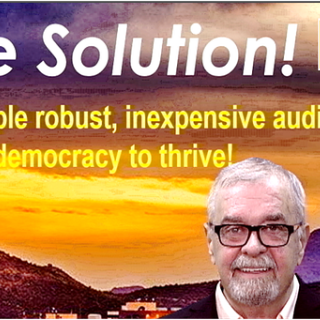Advertisement
Look for the Ohio Legislature to come out very soon with a bill to bail out FirstEnergy for its two nuclear plants on Lake Erie – Davis-Besse near Toledo and Perry east of Cleveland. FirstEnergy says it will close its nuclear reactors without a massive ratepayer bailout, attempting to blackmail the legislature with a hollow “threat.” FirstEnergy has been a major donor to some powerful politicians.
Nuclear utilities are getting smarter about getting public bailouts. In Illinois, Exelon is asking that the state take over from the regional transmission authority. Then Illinois could increase the capacity charges for nuclear power. They claim that this is not a nuclear bailout!
In Ohio’s proposed FirstEnergy bailout in 2018, one argument the sponsors gave was that without nuclear we would be left in the dark. That didn’t ring true, though, so they started quoting a new mantra: Nuclear Power should be given zero emissions credits!
WHAT ZERO EMISSIONS?
- Nuclear is an immense industry that uses lots of carbon. Uranium mining, milling, refining, conversion, enrichment, fuel fabrication, MOX fuel, transportation and building reactors and numerous other facilities use immense amounts of carbon. How much energy will be needed to keep nuclear waste isolated for hundreds of thousands of years?
- All nuclear facilities are currently releasing radioactive pollution. Nuclear power plants are allowed to, and all do, have regular radioactive releases into the air and water. Uranium mining, milling and refining all produce dangerous waste piles and emissions of radioactive and hazardous materials, including radon gas. All through the industrial facilities in the previous paragraph, radioactive contamination occurs.
- What you never hear mentioned by the nuclear industry:radioactive nuclear waste! There is no real “disposal” solution for nuclear waste. High Level Radioactive Waste (used fuel rods, or spent nuclear fuel) is accumulating at reactor sites. It is being stored in dangerously overcrowded cooling pools and in thin dry canisters that cannot be monitored or repaired.
- Heat from Davis-Besse and Perry is warming Lake Erie. This is particularly problematic in the shallow Western Basin, where it contributes to toxic algal blooms. Vast quantities of steamemitted not only warm the air, but also have a marked greenhouse effect. Fish and other aquatic life are killed by heat and mechanics when water is sucked in for cooling.
BAIL OUT A BANKRUPT COMPANY?Not by increasing our electric bills. Not by manipulating regulatory or regional transmission rulings. Not by rigging the system with a capacity change. Not by calling nuclear by another name, such as zero emissions facilities. And not in a bill that gives a few nods to renewables and efficiency.
FIRSTENERGY IS DISHONEST:
Five major federal agencies and consumer and environmental groups filed strong legal objections to FirstEnergy Solutions’ restructuring plan. The court denied FirstEnergy abonus plan that excluded union members. FirstEnergy “competes” by pushing legislation that blocks cheaper renewables development.
MAINTENANCE, REPAIRS, UPGRADES DEFERRED:
Longer periods between inspections. Emergency plans not updated. Flooding and other recommendations from Fukushima Lessons Learned not implemented. FirstEnergy is not meeting its obligation to fully fund decommissioning at Davis-Besse and Perry. The industry is pushing the Nuclear Regulatory Commission to cut back on inspections. While Davis-Besse’s shield building continues to crack. The Ohio Legislature is not going to require FirstEnergy to spend bailout money on much-needed upgrades.
RADIOACTIVE RELEASES, SPILLS, AND CATASTROPHIC RISKS:
How long can you drive an old car? Davis-Besse is operating past its 40-year engineered lifespan. Nuclear reactors have a problem that old cars don’t – weakening of concrete and steel by continuous radioactive bombardment. Lake Erie is a critical resource for drinking water, recreation and livelihoods for millions of people. Even a “small” accident could wreak billions of dollars in property damage, with life-altering health consequences for tens of thousands. FirstEnergy’s Beaver Valley reactors sit only 4 miles east of the Ohio border in Pennsylvania.
NUCLEAR CAN’T COMPETE.
FirstEnergy is already getting a $200 million per year bailout from the Public Utilities Commission of Ohio (PUCO.) This has caused a 5% increase in FirstEnergy electric bills! By contrast, AEP is asking for regulatory approval to lower bills by building wind and solar.
SO WHAT SHOULD THE OHIO LEGISLATURE DO?
PROMOTE SUSTAINABLE ENERGY.
The Ohio legislature must remove obstacles to wind and solar. This will lower electric bills. Wind is available in Ohio for less than 3 cents per KWh. Utility scale solar is available in Ohio for less than 4 cents per KWh. Efficiency saves electricity at about 1.7 cents per KWh. Nuclear’s cost before profit is estimated to be between 6-7 cents.
GIVE ZERO EMISSION CREDITS TO WIND AND SOLAR AND CREATE JOBS!
There are now more jobs in solar and wind than in nuclear or coal. Jobs in solar energy are growing all across Ohio. Wind was booming across Ohio until 2014 when Ohio legislators gave wind the harshest setback regulations in the nation. Ohio was the largest manufacturing state for U.S. wind and solar equipment until the 2014 law changes which froze clean energy. Ohio Power Siting Board applications for new solar in 2018 are 7 times the total existing solar in Ohio.
COMMUNITIES NEED AID, NOT UTILITIES.
Unemployed workers, vacant homes, decreased tax revenues, business closures – can constitute a vicious circle. Far more could be done if money went directly to communities. Electric rate increases double the unfairness because they hurt poor families most. Ohio can and should support reactor communities.
NUCLEAR JOBS CAN BE RETAINED.It is cost effective, more efficient and decreases safety risks if decommissioning begins as soon as a nuclear plant closes. The workers at Davis-Besse and Perry are experts on the workings of their plants. By far the smartest thing to do would be to rehire these workers to begin the decommissioning process. Waiting years for decommissioning and hiring new workers unfamiliar with these plants would pose significant cost increases and safety concerns.
ACTION NEEDED! Call/write your Ohio senator and representative. Find them at http://legislature.ohio.gov.




